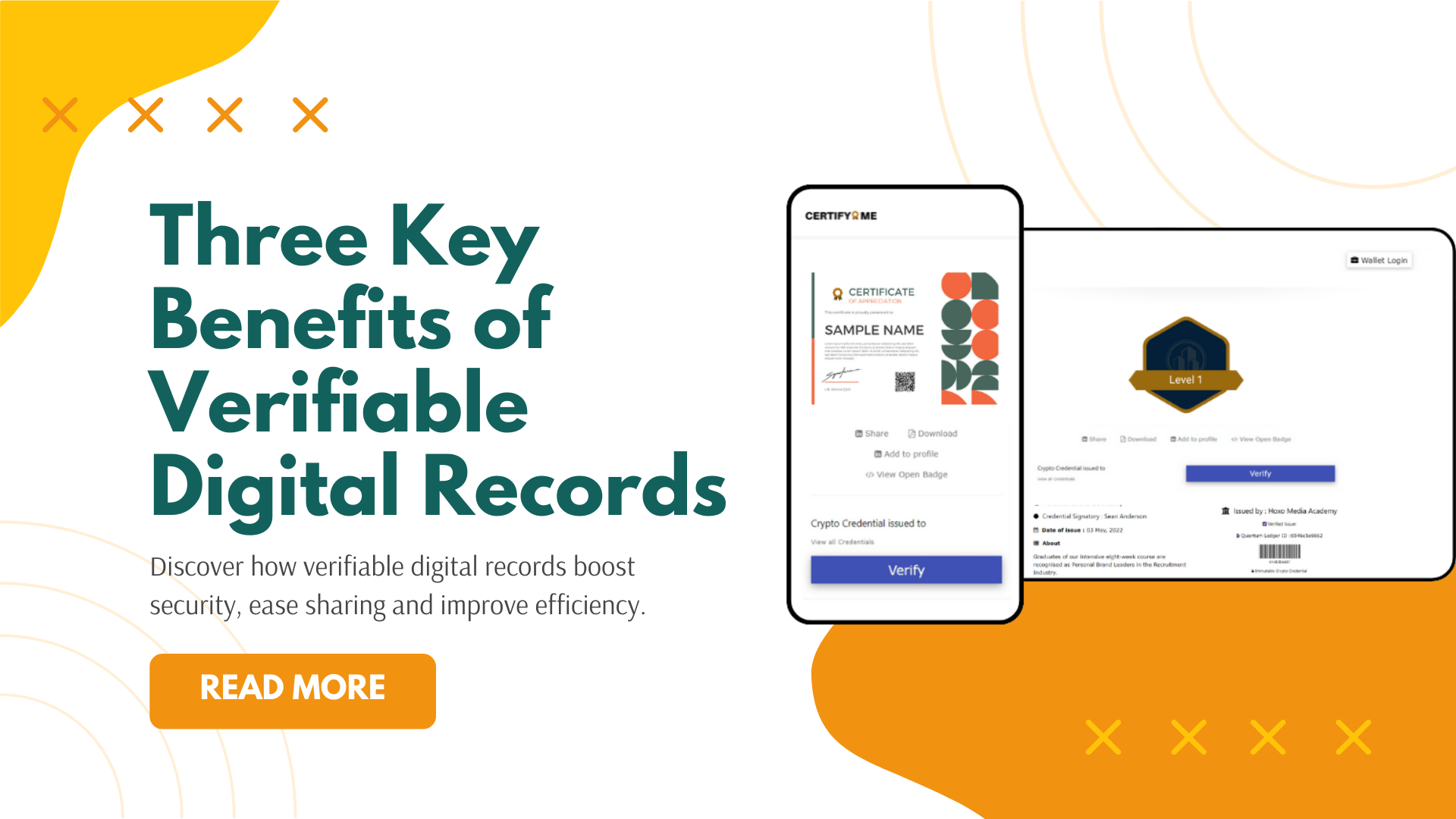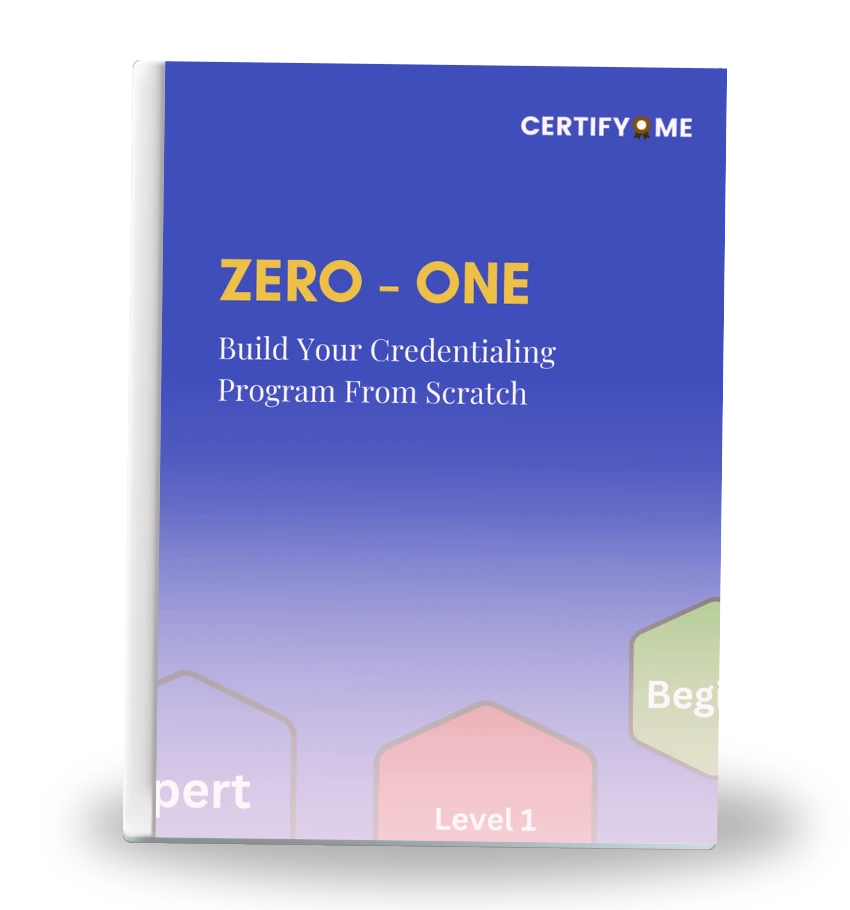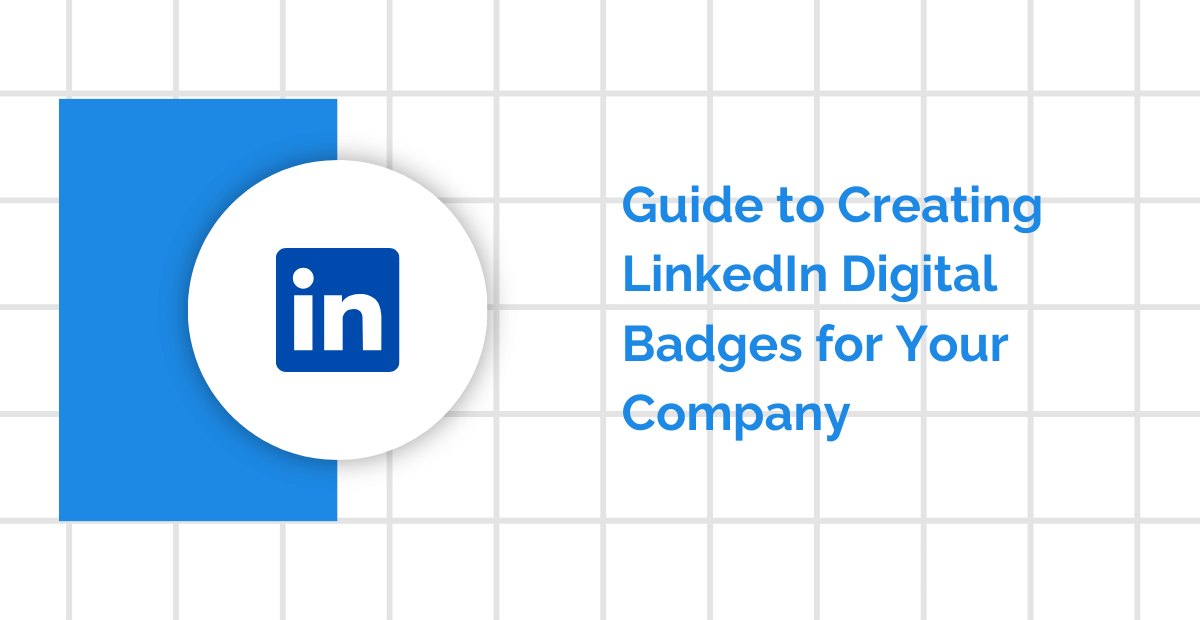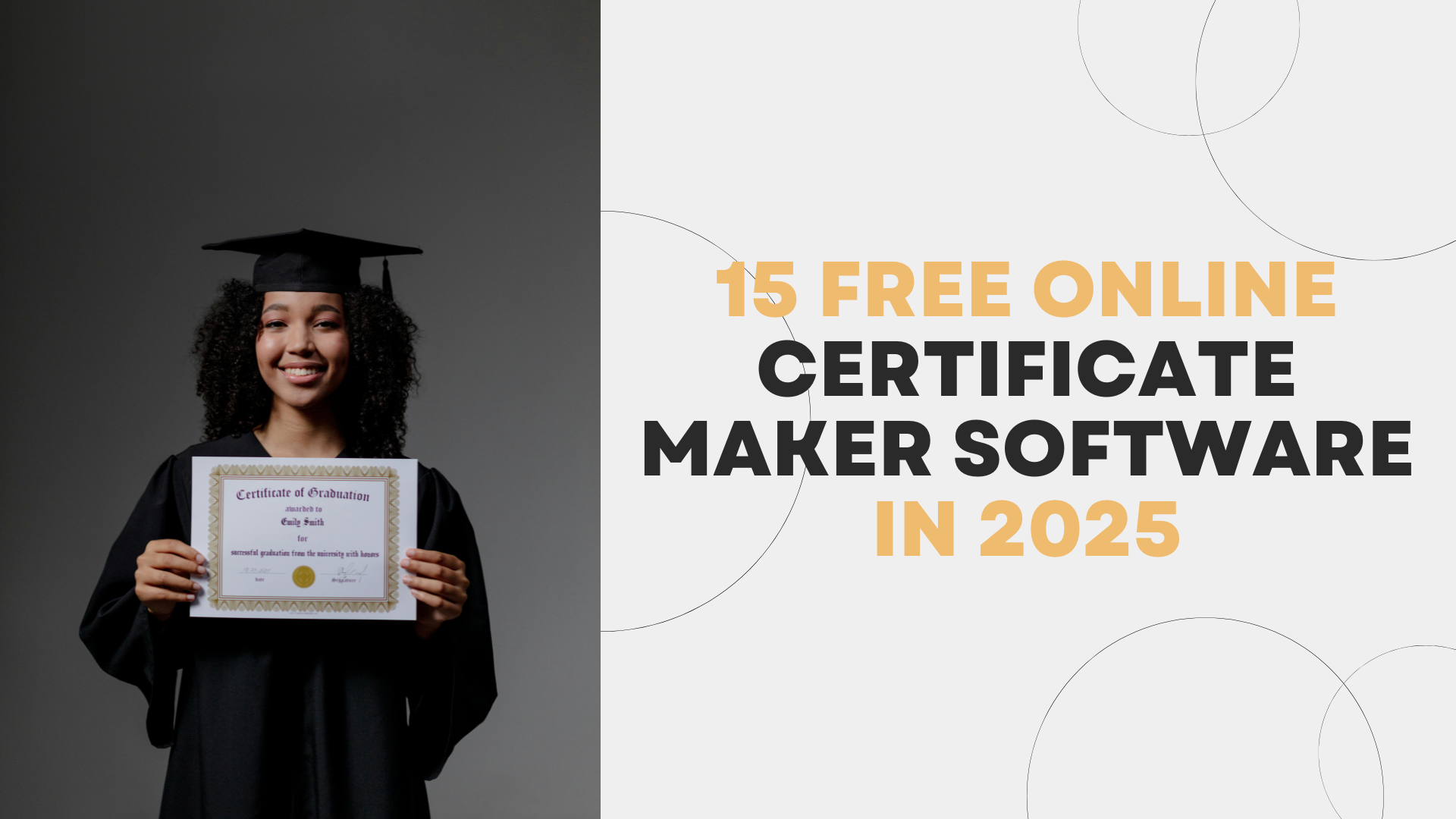Ever wonder if there’s a better way to prove what you’ve accomplished—without digging through drawers or chasing down signatures?
Most of us have been there: trying to find a lost certificate before a job interview, waiting weeks for a university to send our transcript, or worrying if someone might fake a document that took us years to earn.
That’s where verifiable digital records come in—they’re like the digital version of a lockbox for your credentials, but smarter and much easier to share. Think of them as your digital cheat sheet for life: easy to access, hard to fake, and built to make verification painless for everyone involved.
In this blog, we’ll break down the three most effective advantages of verifiable digital records, in plain language you can actually understand.
1. Enhanced Security and Trustworthiness
The Problem with Traditional Credentials
Think back to the last time you had to prove your academic achievements or professional qualifications. Most likely, you relied on paper certificates, transcripts, or letters sealed with ink stamps. While these physical documents have been the standard for decades, they come with a bundle of challenges that often go unnoticed—until you really need them.
First, security is a major concern. Paper credentials are easy to lose, get damaged by water or fire, or simply wear out over time. Worse, they are vulnerable to forgery. A fake diploma or certificate can be created by skilled counterfeiters, making it difficult for employers or institutions to trust what they see without additional verification steps.
For example, hiring managers sometimes have to spend hours calling universities to confirm a candidate’s degree—time that could be better spent elsewhere. Second, verifying these documents is slow and inefficient. You might have had to mail a copy or scan your certificate and wait days or even weeks for confirmation. This delay can cause frustration—especially when you’re applying for jobs, scholarships, or further studies under tight deadlines.
Imagine needing to prove your credentials for a scholarship application, only to be stuck waiting for your school to respond. Meanwhile, opportunities can slip away.
Finally, physical storage and management create headaches for both individuals and institutions. Students often pile up folders or boxes of certificates that are difficult to organize or access.
Universities and employers, on the other hand, face mountains of paperwork that need secure storage, retrieval, and careful record keeping to avoid errors or loss. Manual filing systems and outdated databases can lead to mistakes or misplaced documents, potentially affecting a student’s future.
In short, while traditional credentials have served their purpose, their limitations can cause serious inefficiencies and trust issues in today’s fast-paced, digital-first world.
The Digital Solution
Verifiable digital records utilize technologies like blockchain and digital signatures to ensure authenticity. Each credential is:
-
Tamper-Proof: Once issued, the information cannot be altered without detection.
-
Easily Verifiable: Employers or institutions can confirm legitimacy with a simple click or scan.
-
Securely Stored: Digital credentials are less susceptible to loss or damage compared to physical documents.
-
Time-Stamped: These records carry a digital timestamp that provides an extra layer of verification.
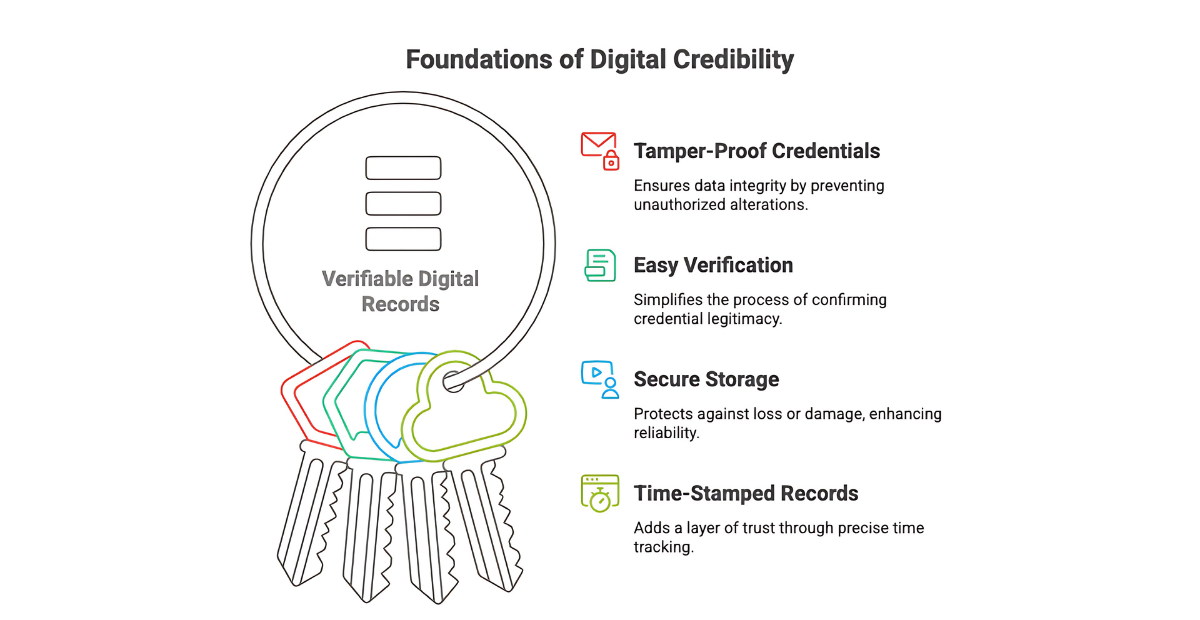
To understand how these credentials get validated in real-world scenarios, check out our guide on how to validate digital skills using secure, modern tools.
Example: A university registrar can quickly verify a graduate’s degree through a secure digital platform, eliminating the need for manual checks. And for employers, it means no more second-guessing a candidate’s claims. One scan, and the record speaks for itself.
This enhanced security builds real trust between institutions, students, and employers—because in a digital world full of deep fakes and false claims, authenticity matters more than ever.
2. Streamlined Sharing and Accessibility
Challenges with Physical Documents
If you’ve ever had to send a paper transcript or diploma to someone, you know it’s not as simple as it sounds. Physical documents come with their own set of hurdles that often slow things down or cause unnecessary stress.
First, sharing paper credentials can be a logistical nightmare. You might need to scan, photocopy, or even mail the originals or certified copies to employers, universities, or certification bodies.
Each step adds time, cost, and potential risk. What if the mail gets lost? Or the scan is unclear? These small hiccups can quickly turn into big problems, especially when deadlines loom large.
Second, there’s little control once you send them out. Once a physical certificate leaves your hands, you can’t track where it is or who’s looking at it. This loss of control can feel uncomfortable, particularly with sensitive information. It’s like handing over a key to your personal records without knowing if it will be returned.
Third, the risk of damage or deterioration remains high. Paper is fragile—exposed to water, tearing, fading, or other wear and tear. Over time, important documents can become unreadable or unusable, especially if not stored properly.
Think about that old high school diploma stuck in a drawer somewhere—how many of those have been ruined over the years?
Finally, errors and mismatches happen frequently. When documents are manually handled—copied, mailed, or filed—mistakes creep in. Wrong copies can be sent, signatures may be missing, or documents could get mixed up. These errors can lead to delays, confusion, or even doubts about authenticity.
Put simply, relying on physical documents to prove your achievements is often slow, risky, and frustrating—making the case for digital solutions all the more compelling.
Advantages of Digital Records
Digital credentials simplify the sharing process:
-
Instant Access: Recipients can access their credentials anytime, anywhere.
-
Easy Sharing: Credentials can be shared via email, social media, or embedded in digital portfolios.
-
Controlled Visibility: Holders can manage who sees their credentials and for how long.
-
Mobile-Friendly: View and share your credentials directly from your phone or tablet.
-
Permanent Storage: No need to dig through old emails or ask your college admin for reprints.

Analogy: Think of digital credentials as streaming music—accessible on-demand, without the need for physical media.
So whether you’re applying for a summer internship from your dorm room or showcasing your certifications on LinkedIn, these digital records are always at your fingertips.
That kind of convenience can be a real game-changer for students on the move and administrators managing multiple requests at once.
3. Improved Efficiency for Institutions and Employers
The Administrative Burden
Managing paper credentials is no small task for universities and employers—it’s a full-time job wrapped in endless paperwork. Behind the scenes, administrative staff spend countless hours issuing, verifying, filing, and retrieving physical documents, often juggling piles of paperwork along with their regular duties.
This workload isn’t just tedious—it’s a drain on time and resources that could be better spent on supporting students or improving services.
For example, registrars frequently handle requests for transcripts or diplomas, carefully checking every detail before issuing the document. When a verification request comes in from an employer or another institution, staff must dig through files or search legacy databases to confirm authenticity. Each step involves manual labor, which increases the chance of human error—misfiled records, typos, or missing signatures can throw a wrench into the process and delay outcomes.
Cost is another factor. Printing, mailing, and storing physical records aren’t cheap. Institutions spend money on paper, envelopes, postage, and secure storage facilities.
Over time, these expenses add up, especially for schools with large graduating classes or high verification volumes. The cumulative cost can strain budgets, diverting funds away from educational programs or student services.
Moreover, the manual nature of this work means slow turnaround times. Students and employers alike face waiting periods—sometimes days or weeks—before documents are issued or verified.
This lag can cause frustration, missed opportunities, or even impact job offers and admissions decisions. In a world where speed and accuracy matter more than ever, these delays stand out as a serious bottleneck.
Overall, the administrative burden of managing traditional paper credentials is heavy. It slows processes, increases costs, and leaves room for error challenges that verifiable digital records are designed to solve with efficiency and precision.
Digital Transformation Benefits
Adopting verifiable digital records leads to:
Reduced Administrative Load: Automated systems handle issuance and verification.
-
Cost Savings: Less spending on paper, printing, and postage.
-
Faster Processes: Immediate issuance and verification speed up hiring and admissions.
-
Scalability: Systems can handle high volumes of records without breaking a sweat.
-
Improved Record-Keeping: All records are stored in one secure place, making audits and compliance easier.
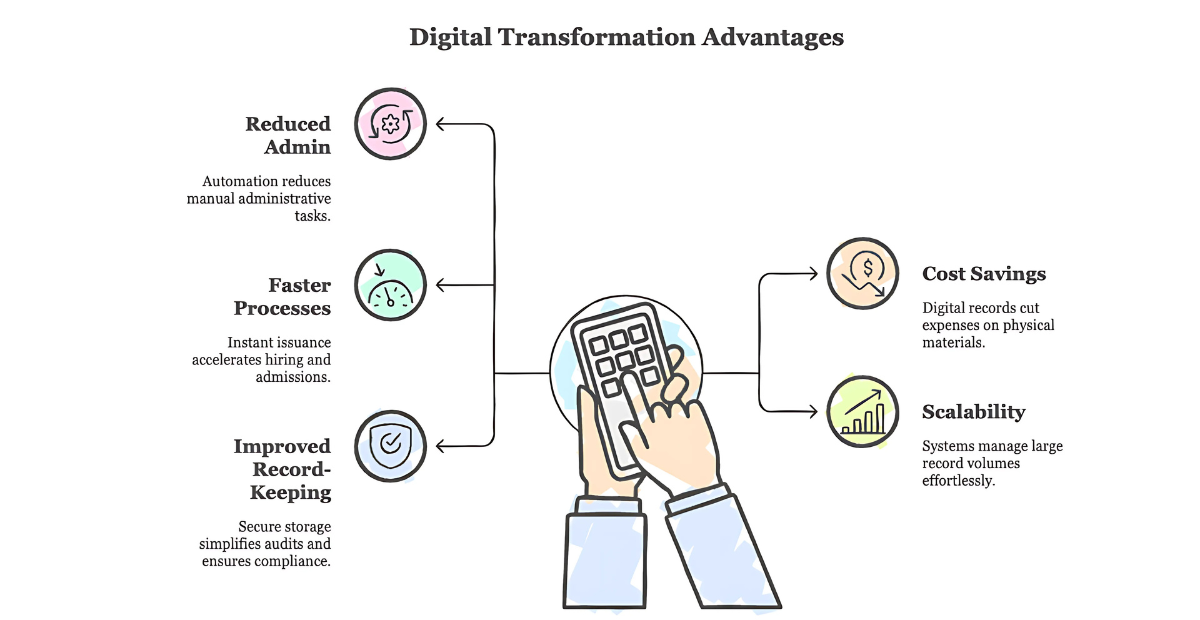
Case in Point: A company can instantly verify a candidate’s certifications during the recruitment process, accelerating decision-making. And for university registrars? No more dealing with stacks of request forms or mailing delays—just a few clicks, and the job is done.
Want to see how real companies use this in hiring? Read this HR case study to see how digital records helped streamline talent verification.
This kind of efficiency doesn’t just save time—it improves the overall experience for everyone involved. Less friction, less follow-up, and more time for what really matters.
Additional Benefits
Environmental Impact
By eliminating the need for paper and physical delivery, digital credentials contribute to sustainability efforts. Institutions can significantly reduce their carbon footprint, while students and employers benefit from a system that supports a greener planet.
Over time, this shift not only saves trees but also reduces energy used in production, transportation, and storage.
Lifelong Portability
Digital records remain accessible throughout an individual’s career, simplifying transitions between jobs or educational pursuits.
You don’t have to worry about losing access after graduation or when switching institutions. These credentials live in your digital wallet—ready to go when you are.
Consistency and Standardization
Verifiable digital records help maintain a consistent format, making it easier for employers and institutions to interpret them.
With standardized layouts and verifiable data, there’s less confusion and fewer mistakes during reviews. It’s like having everyone speak the same language when reviewing credentials.
Real-Time Updates and Flexibility
Need to update your certification or add a new skill badge?
With digital records, updates can be made in real time by the issuing authority and reflected immediately. This keeps your credentials current and relevant—especially valuable in fast-evolving industries.
Integration with Modern Tools
Many digital credentialing platforms integrate easily with LinkedIn, learning management systems (LMS), and digital resumes.
That means your verified skills can appear right where employers are looking. It’s convenient and amplifies your visibility.
Want to know how eLearning programs are leveraging digital credentials? Take a look at this eLearning case study to see it in action.
Embracing the Digital Future
Stepping into the world of verifiable digital records isn’t just about keeping up with technology—it’s about reshaping how we trust, share, and manage our academic and professional achievements.
The shift from paper to digital represents a fundamental change in convenience and security, tailored to meet the pace of today’s fast-moving environment. As more universities and organizations adopt these systems, it’s clear that digital credentials aren’t a passing trend but an evolving standard.
Explore deeper insights into where the industry is headed in our blog on the future of digital credentials.
The benefits go beyond just making life easier. By embracing digital records, students gain control over their achievements, deciding exactly when, where, and with whom to share their verified credentials. No more waiting for a letter to arrive in the mail or worrying if your documents might get lost along the way.
Employers, meanwhile, can speed up hiring by verifying qualifications instantly, cutting through the guesswork and delays. For administrators, automation reduces errors and frees up valuable time to focus on higher-impact tasks.
Looking ahead, the potential of verifiable digital records is only growing. Integration with professional networks, learning platforms, and even government services means these records can become powerful tools in lifelong learning and career development.
Imagine your verified digital diploma seamlessly linking to your LinkedIn profile or your latest certification updating in real-time across all your professional documents. It’s a future where credentials are as dynamic as your skills.
If you’re curious about how this works in real life, CertifyMe makes it easy to get started.
Their platform helps universities issue tamper-proof, instantly verifiable digital records that are simple to use and even simpler to share.
Whether you’re a registrar, a department head, or a student thinking ahead, CertifyMe helps you ditch the paper trail without missing a step. If that sounds like something you—or your school—could use, book a quick demo call and see what it looks like in action.
Sometimes, the best place to start is just seeing it for yourself.

 Author :
Author : 